
Email : [email protected] Or General Mailer
 |
Jai Chavan's
"Dance-Sport" Email : [email protected] Or General Mailer |
| Back || Master Pg. || Overview || Contents || Alphabetical Index || Home || Next |
Samba: Basic Sequence: Part 2
| The first basic sequence. |
 |
THE DIRECTIONS
(Generally when facing): A: Centre. B: Diagonal to Centre. C: LOD (Line of Dance). D: Diagonal to Wall. E: Wall. F: Diagonal to Wall against the LOD. G: Backing the LOD or facing against the LOD. H: Diagonal to Centre against the LOD. |
Note: In the diagram above the dancer is facing and is square in the direction C.
Basic:
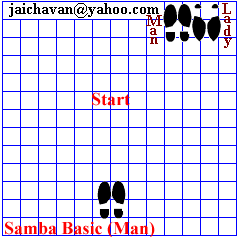 |
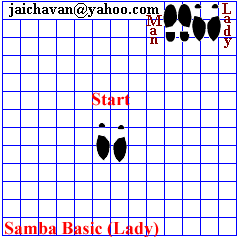 |
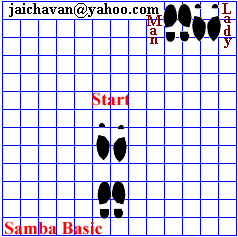 |
1. Forward Basic:
Transfer weight on to the Right foot, thus the Right foot is the stationary foot
and the moving foot is the Left foot.
1. Move forward and step on the Left foot with a comfortable stride for the
count 1. Immediately draw the Right foot to the Left foot, and do not lower it
to the floor as yet.
2. Keeping feet close together take part weight on the ball of the Right foot
for the count &.
3. Replace body weight on to the Left foot for the count 2.
Similarly the forward Basic could be done with the Right foot.
2. Backward Basic:
Transfer weight on to the Left foot, thus the Left foot is the stationary foot
and the moving foot is the Right foot.
1. Move backward and step on the Right foot with a comfortable stride for the
count 1. Immediately draw the Left foot to the Right foot, and do not lower it
to the floor as yet.
2. Keeping feet close together take part weight on the ball of the Left foot for
the count &.
3. Replace body weight on to the Right foot for the count 2.
Similarly the Backward Basic could be done with the Left foot.
Exercise:
1. Forward Basic followed with the Backward Basic. Here if one starts with the
Left foot moving forward then the Right foot moves backward for the second half
to the Basic. Similarly if one starts with the Right foot forward then the Left
foot moves backward.
This exercise can also be started by initially moving backward.
2. This exercise can also be practiced with a few forward Basic followed by
equal number of backward Basic.
3. This exercise can be done in pairs in regular hold, as soon one is
comfortable with the basic.
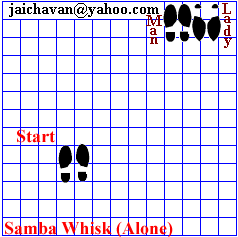 |
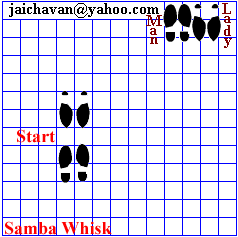 |
3. Whisk:
Transfer weight on to the Right foot, thus the Right foot is the stationary foot
and the moving foot is the Left foot.
1. Move the Left foot to ones side with a comfortable stride, for the count 1.
Immediately thereafter draw the Right foot close to the Left foot without weight
(donít place the Right foot on the floor).
2. For the next count &, step on the ball of the Right foot with part
weight. The right foot is placed behind and close to the Left foot such that the
Left heel and the Right ball almost touch and the angle between the feet is
about 45 degrees.
3. For the next count 2, replace body weight on the Left foot.
Similar is the movement when started with the Right foot.
Exercise:
This exercise can be repeated ad libitum alone or in regular hold, with a dance
partner.
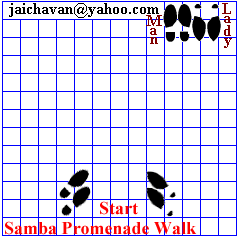 Slow |
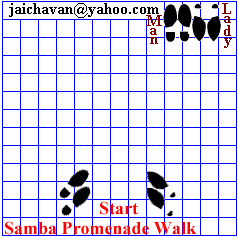 |
4. Promenade Samba Walk:
Transfer weight on to the Left foot, thus the Left foot is the stationary foot
and the moving foot is the Right foot.
1. Move forward with the Right foot and comfortable stride and step on it for
the count 1, retaining the Left foot in place with the Left heel off the floor.
2. For the next count &, move the Left ball slightly behind and take part
weight on it.
3. For the next count 2, move the Right foot slightly behind and replace weight
on it. Now the Left foot is free and the walk could be resumed with this foot.
Exercise:
All these Walks are forward, alternating between the Right foot and the Left
foot, and one can progress continuously forward.
When dancing in pairs, stand in promenade position in regular Hold (an angle
between of about 45 degrees between the dancers, thus manís right is closer to
ladyís left side, and similarly manís left side is further away from
ladyís right side. With reference to the figure on the top, man faces and is
square in the direction B, and the lady is facing and is square in the direction
H, both move/dance the Promenade Samba Walk in the direction A.
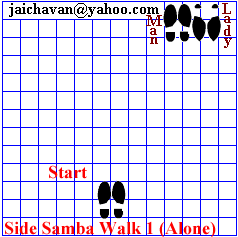 |
 |
5. Side Samba Walk:
Transfer weight on to the Left foot, thus the Left foot is the stationary foot
and the moving foot is the Right foot.
1. Move forward with a comfortable stride and step on the Right foot for the
count 1.
2. For the next count draw the Left foot towards the Right foot and then curve
it to the side (to the left side) and take part weight on to it.
3. For the next count 2, replace the full body weight on the Right foot after
drawing it towards the Left foot.
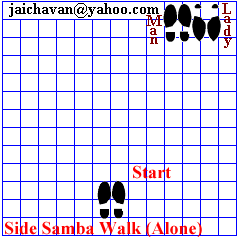 |
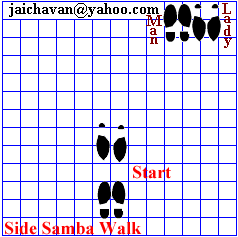 |
Similarly is the movement when starting with the Left foot. And on could
continuously forward.
Exercise:
1. When practising alone one could do so alternately once with the Left foot and
then the Right foot, and so on.
2. When practising pairs in regular hold, stand in promenade position and move
forward. When the man starts with the Right foot (lady with the Left foot) then
both the partners would be moving slightly apart, and then they would come close
again when the Side walk is repeated with the manís Left foot (ladyís Right
foot).
3. The same exercise can be done alone or in pairs with turns as well.
| Back || Master Pg. || Overview || Contents || Alphabetical Index || Home || Next |